I'm Tom - I write for a living, and this is my space for all my writing that doesn't quite fit anywhere else. Opinions on Magic the Gathering, video games, movies and short stories ahoy!
Don't wanna be here? Send us removal request.
Text
A Deep Dive on Threat Evaluation in Immortal Redneck
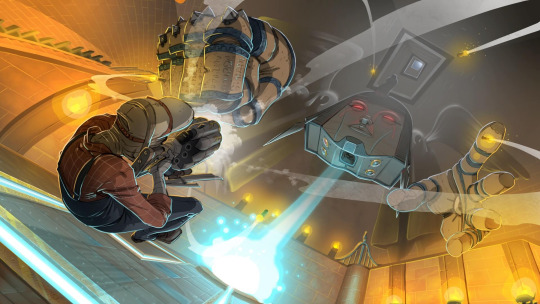
Sometimes when I play a game, one aspect or mechanic from the game will stand out to me so much, that it can’t help but play around in my head. As I approach the 30 hour mark in first-rogue-person-shooter-like Immortal Redneck, I find myself thinking a lot about ‘threat evaluation’ in games. And if you couldn’t guess, this is because Immortal Redneck does this very well.
To clarify, ‘threat evaluation’ is when the player processes information provided by the game, and then uses that information to inform their course of action in order to maximise their chances of survival or success. If you’ve ever made a concerted effort to kill a specific enemy in a group of enemies, that has been a result of your own ‘threat evaluation’ of that situation.
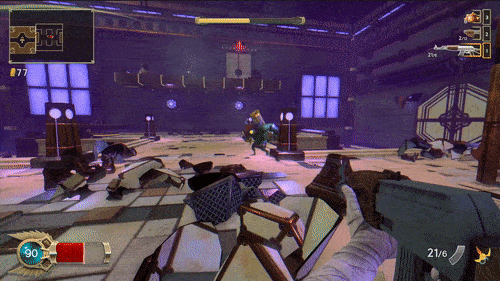
For even more context, Immortal Redneck is a roguelike first-person shooter with a focus on high mobility. You play as a redneck who has found himself mummified, and must ascend randomly generated pyramids, dispensing enemies as you go. Imagine if The Binding of Isaac and Quake had a horrible, screaming baby and you’re pretty close.
Now the classic thing about roguelikes is that you’re expected to die and use the skills and abilities you’ve gained in each playthrough to get further into the game each time. You slowly get further each run by improving not only within the game, but improving as a player of the game. Immortal Redneck has a classic skill tree, but the primary way you stay alive longer is getting better at threat recognition.
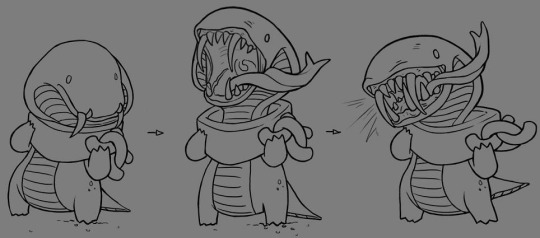
As I mentioned before, threat evaluation is carried out when the player processes information provided by the game, and Immortal Redneck provides this information through excellent enemy design, visual and audio cues.
There are a number of different types of enemies, but a bunch of them fall into the following categories:
Melee enemies
Turret/stationary enemies
Flying shooting bastards
Flying ramming bastards
Summoners
Each type of enemy has their own unique ways of communicating their presence to the player, in order to help you understand what threats you should be aware of. Some enemies pose much more of a threat to your life total than others, so knowing which targets you should prioritise in order to limit the amount of time you have to spend with them attacking you is key.
As you can probably guess from my list, flying enemies are quite high on my threat priority list. Knowing exactly where flying enemies are, what type they are and how to dodge their attacks are key to surviving in Immortal Redneck, and without proper cues, would easily become frustrating. The fact that I never once found this game frustrating is testament to each death being perfect telegraphed by the game, and therefore my fault.
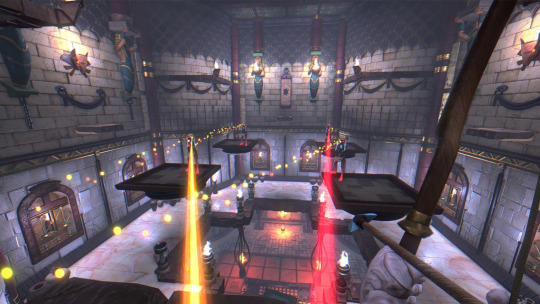
For my first example, I’ll use the melee enemies - which are some of the most common in the game. These enemies will usually make a bee-line for you if you’re somewhere they can reach, and will constantly be trying to hunt you down. These enemies tend to come in two flavours - big and slow and fast and small.
Both of these enemies types signal their presence visually, with their bright colours contrasting with the more muted colours of the environments. Also, the smaller enemies always approach you in multiples, making it easier to spot them as they move as a group. As they can only attack you once they get in range, the key thing with these enemies is being aware of them, and keeping your distance. As long as you keep moving, you’ll be fine - which is why they communicate their presence visually. The moment you can see them, is when you need to factor them into your survival.
What you can’t see, can’t hurt you!
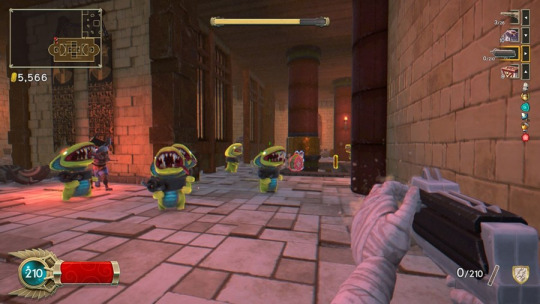
As you could probably guess from my enemy list, flying enemies in Immortal Redneck tend to be the ones that kill me the most. By having the most dangerous enemies fly in the air, this naturally makes them easier to spot whenever you enter a room.
This makes it easy for players to perform threat evaluation, as you can scan the air and make a mental note of the enemies you see, and which ones need to be taken out first. Enemies that fire from you in the air are visually distinct from those who ram you, enabling you to quickly distinguish them from each other.
When you encounter flying enemies who attack you from range, the best tactic is to put parts of the level geometry between you and that enemy, reducing the number of attacks you need to worry about. When it comes to the flying enemies to ram you, you need to take the completely opposite approach - keeping them in your sights is key to making sure they don’t ambush you around corners. You can see why it’s so important to be able to quickly tell the difference now, right?
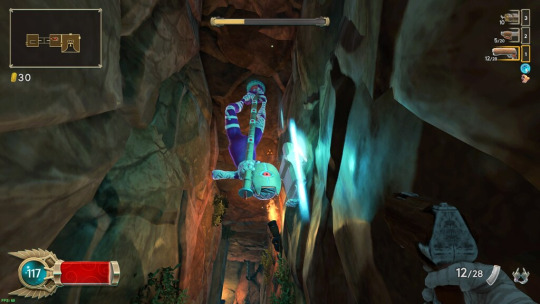
A large number of enemies attack you with ranged attacks, and either stay still or move slightly while trying to aim at you. These turret style enemies always have some kind of bright, charging phase before they fire their attack (which also glows brightly).
You also have enemies who track you with glowing, sniper-style red lasers, which pause and change colour to yellow just before firing. This colour change is another way the game signals incoming attacks so you know exactly when you can move slowly and when you really need to sprint out of the situation you’re in.
Once again, the game is conveying key information (you’re about to be attacked) to the player in a way that can quickly be understood at a simple glance.
The flying enemies who fire at you I mentioned before also do this, helping you to understand when it is necessary to move and when you can take the time to aim your shots properly without the risk of damage.
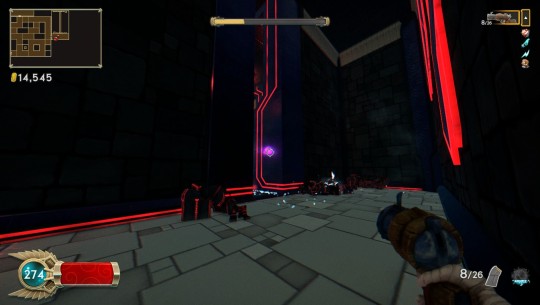
Something I didn’t really notice until I started writing this blog was just how shiny Immortal Redneck is, but it makes perfect sense when you consider everything I’ve talked about so far.
For example, in the screenshot above there is a flying ramming bastard around the corner who glows bright purple. Due to the first-person perspective of the game, I obviously can’t see this enemy as it lurks around the corner. However, thanks to the shiny walls reflecting the bright glow of the enemy, I can anticipate it being there and make sure I take the corner wide enough to avoid damage. Talk about threat evaluation in action!
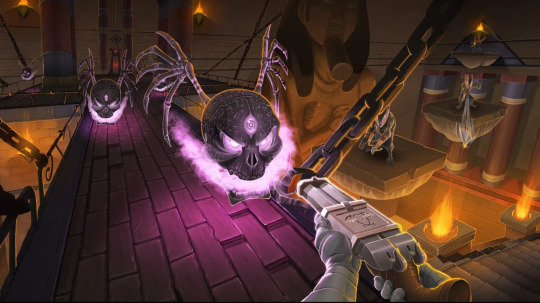
And finally, there are a range of audio cues that the game uses to signal different attacks and enemies. The most obvious example is a spinning melee enemy who makes a constant ‘wooshing’ sound as they traverse the map. A number of enemies also telegraph their ranged attacks with audio cues, meaning you can maintain awareness of them even when they are outside of your field of view.
Also, the frog enemies ribbit a lot. It’s pretty great.
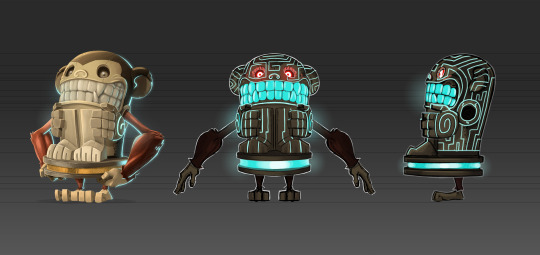
Hopefully my rambling about threat evaluation has provided you some insight into what it looks like when a game does it well. If it has also encouraged you to look into Immortal Redneck, I’m happy to confirm that the rest of the game is also great!
#Immortal Redneck#FPS Games#video games#video game review#indie games#indie game review#games#gaming#review#game design#game dev
5 notes
·
View notes
Text
Adventures in backloggery with Homefront: The Revolution
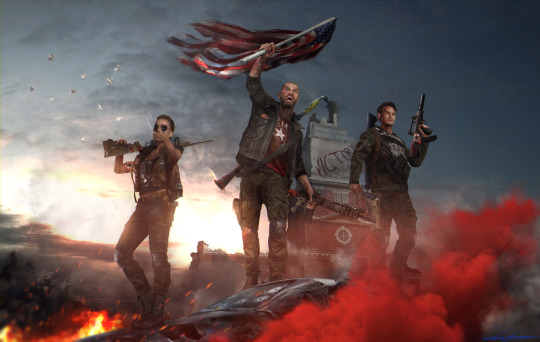
To say the first Homefront left me lukewarm after playing it would imply that I was left feeling anything after that game finished. Painfully derivative with nothing to say about it’s interesting premise, I left that game fully understanding why so many people dismissed it.
For those unfamiliar with the premise of Homefront, here it is, fresh from the wikipedia page: “The game tells the story of a resistance movement fighting in the near-future against the military occupation of the Western United States by a Korea unified under Kim Jong-un.”
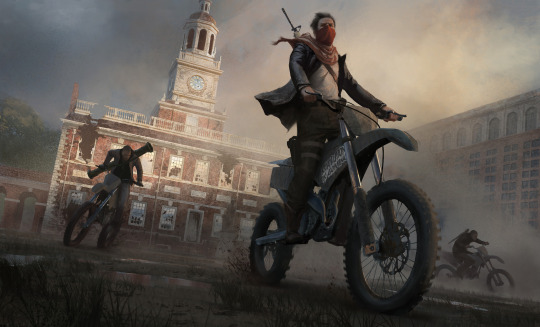
Sounds interesting right? Telling a guerrilla warfare story based on American soil gives you a chance to take a lot of war-story tropes and twist them into new, interesting forms. Turning America into the occupier instead of the occupier offers a lot to explore. Sadly the original game does nothing like that - instead opting for a very simple “We wanted to take back America and we did” story.
So when I overheard through my gaming circles that the general perception of Homefront: The Revolution was hovering around the 6/10 mark, I was under the impression that while it was an improvement over the first game, it was still not a title that was worth my time. I assumed it was a decent yet uninspiring corridor shooter just like the original game.

Imagine my surprise then when I watched one of the latest videos from Jarek the Gaming Dragon and discovered that my preconceptions about shooting dudes in corridors were entirely wrong! This was an open world shooter, in the vein of Far Cry. And not only that, but the story actually has things to say this time!
Instead of North Korea invading the USA due to them being weakened, North Korea becomes a tech powerhouse. Due to poor decisions by their government, the USA slowly goes into financial ruin while they opt to purchase military technology from North Korea.
North Korea provides aid to the US, but this is just a pretence to establish a foothold and exploit the natural resources within the continent. This is presented as the real reason behind the occupation - because we all know that only evil governments invade foreign countries in order to exploit their natural resources, right?
It’s important to note when talking about the story of this game that playing Homefront: The Revolution in the apocalyptic year that is 2020 makes it hit much different than it would have in 2016. For example, the USA neglecting it’s citizens while spending billions on military weaponry is far too close to reality to even be called satire at this point. However, the he game is very ‘gung-ho’ in it’s expression of American values and honour - which clashed with my current view of the country.
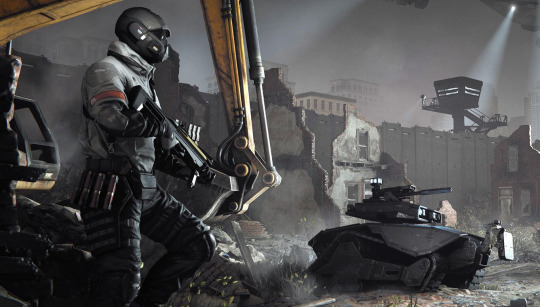
At this point in time, seeing America do things wrong is something that happens on a monthly basis - and seeing people who want to shift the blame for that onto other people is an equally common occurrence. So seeing America ruin itself definitely removes a lot of the sympathy I have for the country as a whole - I of course still sympathise for the common citizen underneath this new regime, but seeing America complain about a foreign power using military might to seize their natural resources isn’t something I can sympathise with the American government suffering through at this point.
Speaking of regimes, seeing Americans actively fighting against a regime who happily deploy lethal force against American citizens (who resist and go against their military police enforced status quo) has also sparked many comparisons to recent events in the US in my mind. I mean, how can it not at this point?
The game does make some effort to comment on the fact that you’re creating more bloodshed and destruction through your actions, but that voice is drowned out by two of the main characters - who’s attitude is “Fuck you, this is America and this is war.” Seeing these characters passionately talk about standing up against the exact evils that America is committing right now makes the whole thing smack of hypocrisy - which isn’t the games fault, but I’d be disingenuous if I didn’t admit it has coloured how I viewed the plot heavily.
Overall, I think the plot does more to explore the themes of the setting than the original Homefront did, but it’s still bogged down in presenting America as the flawless and eternal hero who channels the ‘American Spirit’ through their actions. And this absolutely smacks of hypocrisy in the nightmare-world of 2020.
Also, there is an area of the game where you have to wear a gas mask to survive, but none of the other characters do. They’re expressing their freedoms to breath deadly toxins, I guess?

When it comes to gameplay, it’s not quite true to say that Homefront: The Revolution is a open world game - rather the game is split into a number of open world areas that you unlock as you progress. Keeping different parts of the world silo’d off from each other definitely has benefits from a programming point of view (you don’t have to account for players deciding to go from one side of the map to the other without a loading screen, for one) it also has interesting design implications.
Instead of having to level-gate certain areas of the open world, the game can properly pace each area to your current skill and gear level. You’re also introduced to the different types of zones in a more natural way, and their different mechanics are able to exist separately.
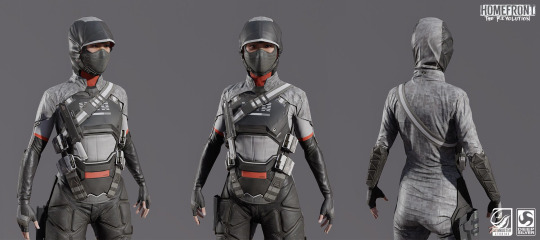
There are two types of area in the game - red zones and yellow zones. These both behave differently in how they express the thematic oppression through gameplay, but I was impressed at just how effective the systems in both areas are at making you feel oppressed.
And that brings me to one of the best things about Homefront: The Revolution - the sense of oppression it expresses through gameplay. It’s important to note that I was playing the game on the hardest difficulty, so this might colour my perception slightly, but I always felt outgunned during almost all my time in the game.
The red zones play similarly to a Far Cry open world, with objectives to complete, collectables to hunt and roaming enemies to attack/get attacked by. Unlike Far Cry however, the environment being full of ruined buildings adds a degree of verticality to the encounters and exploration that makes the smaller world feel much denser than the jungle floor ever did. Here, the game expresses the oppression of the player character through the constant vigilance of patrols and ever-present seeker blimps. These patrol the sky and scan the ground (think the flying drones in Terminator) and will always call in enough reinforcements to kill you. Having to hide under the ruins of collapsed buildings to avoid their search light as they slowly flew overhead always felt tense.
The yellow zones play more like the open world sections of Deus Ex: Human Revolution, with a bigger emphasis on stealth and avoidance of security cameras etc. These areas are typically much more dense than the open red zones, with plenty of corridors and corners to help you break line of sight with enemy patrols. The sheer density of enemies and ways to get spotted in these areas makes you feel constantly on edge, especially when fighting your way out is often a risky option.
And while it doesn’t have as much of an impact, even the health system helps contribute to this sense of oppression. Gone is the regenerating health system, now replaced with a more traditional health bar that must be topped up with healing kits. When you get spotted and enemies take some of your health away, they’re actively chipping away at your resources. This makes each encounter far more threatening, because even if they can’t kill you, they can still whittle you down.

I’m not really a gun guy when it comes to games. It usually takes a game going above and beyond, like in DOOM (2016), to make me actually notice the guns in a game. And oh boy, did I notice the guns in Homefront: The Revolution. Not only do they sound amazing, but they’re extremely well animated and customisable.
The coolest gameplay mechanic in the game is by far the gun customisation mechanic. To summarise, each weapon has two drastically different alternative modes that effect how the gun performs. For example, you can change the stealth-enabling crossbow into a room clearing flamethrower should the need arise. And you can do this on-the-fly while you’re in the game.
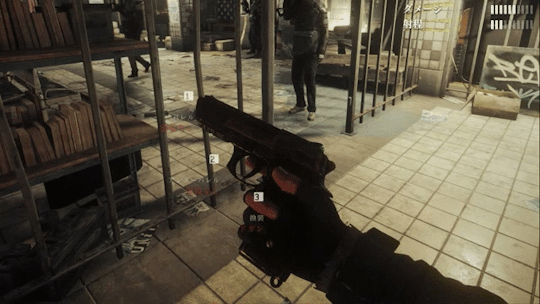
Hoping behind cover to change my assault rifle into a sniper rifle in order to take out distant enemies never stopped feeling cool. Seeing the detailed animation of you customising the gun yourself went a massive way in that feeling of coolness. You can also add attachments to your weapons such as silencers in order to adapt to situations as they arrise.
Having you perform these actions yourself adds a lot to the feeling of being a scrappy resistance fighter, having to create your own tools for the job at hand.
Despite all this praise, I can still see why this game sits at a 6/10 rating. Numerous times during my playthrough I would get hard crashes that would require a complete exit from the game. At one point, an NPC blocked a doorway and I needed to reload from a recent checkpoint to escape my new NPC created prison.
I’ve heard that on launch the game was even worse technically, and while the game is definitely good in my eyes, I can see how technical issues could make you easily lose patience with it. It doesn’t quite reach the levels of praise where I’m willing to fully overlook the crashes I’ve experienced, and if it was worse I could see that effecting my view of the game.
Also, the stealth system leaves much to be desired. Despite coming out 4 years after Far Cry 3, the game does nothing to improve on the basic stealth system that game established of “If I see you, my triangle is going to get bigger until I really see you”. This under-baked stealth system led to me mostly abandoning stealth once I’d gained enough gear to handle encounters, despite me being a big fan of stealth options.
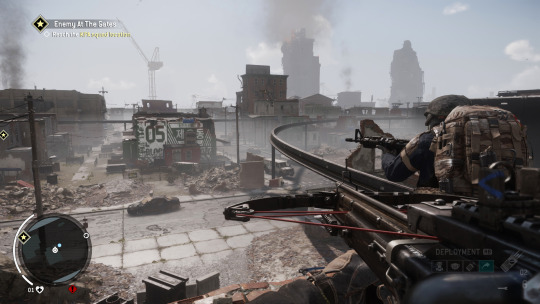
Overall, I’m glad that I gave Homefront: The Revolution a shot after all these years of it sitting in my Steam library. At this point, open world titles have a long list of ‘must haves’ thanks to the ubiquity of Ubisoft titles refining the genre. When looking at these titles then, it becomes a case of looking at what is done differently, and the gun system, feeling of oppression and divided world have definitely left an impact on me as a game design nerd.
If you’re looking for an open-world game and don’t mind the occasional crash, it’s definitely worth looking past those 6/10 reviews for the 7.5/10 game that is lurking underneath.
5 notes
·
View notes
Text
Adventures of being a very big spaceman: Warhammer 40k: Space Marine
Despite hearing a lot about the Warhammer series, it’s never been one that I’ve actually ‘delved’ into. I know that Chaos is a thing, I know there's a big man who sits on a chair... And that's about it.
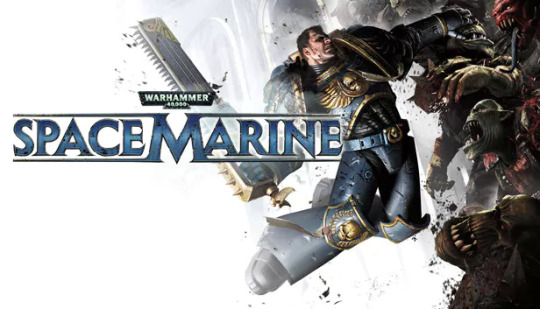
As a welcome to the Warhammer universe, Spare Marine is an odd one. Focusing on a small squad of marines on a single planet helped to keep me from being overwhelmed, but it also never went beyond that small planet. I felt like I was a small part of a much larger conflict, but there was very little explanation as to what that conflict actually was. Maybe if I knew more about the 40k deep lore, it'd make sense. Guess I'll need to do some Wiki reading now that I've finished the game!
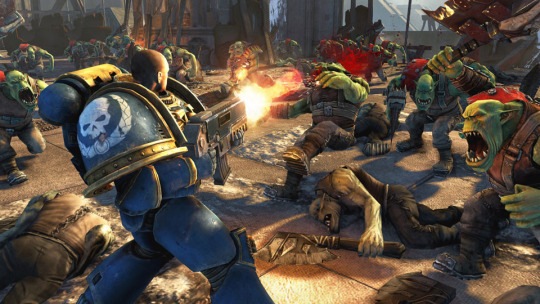
In terms of the game itself, it plays very much like a Gears of War-style cover shooter, if you replaced the cover with a deeper melee combat system.
As I lumbered about as a human tank, it took me some time to get accustomed to the fact I should actively be throwing myself into combat. By performing 'finishers' on opponents, you instantly restore a chunk of your health.
The game breaks up the combat with different forms of combat, the highlight being the sections where I was given a jump-pack. This changes the game from a corridor shooter into a more open-ended affair where you can quickly jump from one end of the battlefield to another, satisfyingly slamming into groups of Orks as you do.
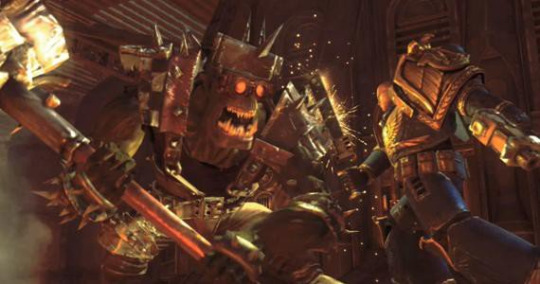
You can tell that the people who made this game had one thing in mind when designing it. They wanted you to feel powerful - and they've achieved that in spades. All of the finisher animations for your melee attacks are suitably brutal, and employ subtle tricks to add to the feeling of weight.
One particular animation sees you knock an enemy to the ground, and then slam your foot on them to crush them. Another game might have that just be it, but in Space Marine the animation triggers a short window of slow-motion, before your stomp sends out a shockwave that hits nearby enemies. You can also freely rotate the camera during this animation, giving you the perfect opportunity to decide on who your next victim will be.
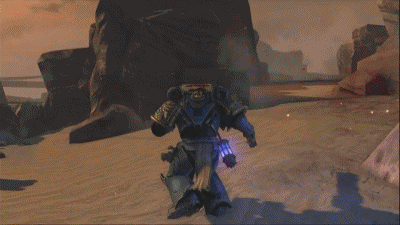
The slow-motion effect also gives you a second to tactically look at your surroundings, something that is very needed given how chaotic fights can be. The weapon variety is also decent enough to keep you interested, although there's nothing here that stands out as much as the special guns of Gears of War does. Instead of welding a Hammer of Dawn, you ARE the Hammer of Dawn.
The campaign is short, but I felt like it was a good length for the game. If it had been about 3 hours longer, it might have started to overstay it's welcome. I went into this game expecting a 6/10 shooter that would introduce me to the 40k lore. Instead I came out without learning anything about the 40k universe, but with a much more positive outlook on the game itself than I expected.
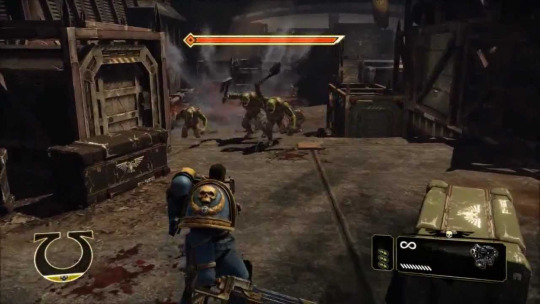
So if the meaty meat men of Gears of War weren't meaty enough for you, I can highly recommend this game for it's meat content.
1 note
·
View note
Text
Adventures in backlog: 140, a minimal rhythm platformer

In an effort to once again get through some more of my Steam games, this time I’ve been taking it from the top - literally. 140 is described as a challenging minimalistic platformer, but I’d be more inclined to call it a rhythm game.
The aim of the game is to reach the end of each level, by jumping over obstacles. So far, so platformer right? The difference with 140 is that all of the obstacles are timed to the in-game music.
So obstacles will move in and out of your way to a set time. The gimmick? That the timings of these obstacles match the backing track, and as you progress and more obstacles are added, the track gets more complex.
At this point, it’s easier to demonstrate via the games soundtrack:
youtube
So for example, there will be platforms that warp on every 4th beat of Track 3. Sure, you can just learn to anticipate it visually, but that would be missing the point. Instead, you can listen to the music and know when the next platform is going to appear.
The game makes this more complex by adding extra layers onto the soundtrack - adding another group of obstacles doesn’t remove the previous ones, so now you have to listen out for one specific beat and ignore the others.
I found that by humming/singing the beat to myself, I immediately became much more likely to land jumps and perform well in the game. It’s hard to single out the tracks by just listening, but by forcing myself to sing along to the beat I needed to be aware of, I could focus on it much more effectively.
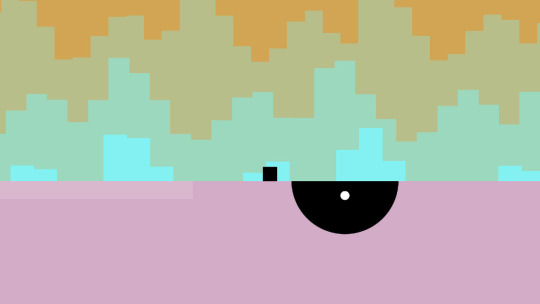
The art style is indeed minimal, with everything consisting of solid block colours. According to Steam I beat the main game in about an hour, with there being a bonus “mirror world” for anyone who still wants more. By the time I’d finished the main game, I felt like I’d experienced everything that 140 had to show me. I’m definitely glad it didn’t overstay it’s welcome - instead I left feeling positive about this weird little rhythm game.
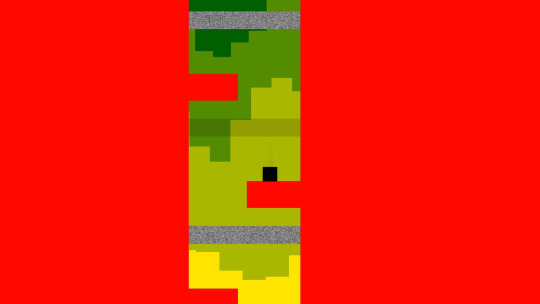
0 notes
Text
How I (nearly) ruined Rise of the Tomb Raider for myself
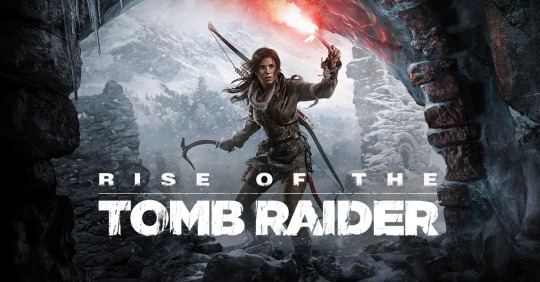
At one point in the Rise of the Tomb Raider story, a character is stabbed and Lara needs to defend the building he’s in. Like everything else in the game, the lines are delivered well and the sense of urgency is conveyed to the player effectively.
Unfortunately for the game, I decided that I was in the mood to take on one of the optional challenge tombs. So I spent the next 15 minutes exploring and completing an exciting tomb, before I returned to the main plot. Of course, all the pre-scripted cutscenes played on like I hadn’t taken a quick break to raid some tombs.
So why did I choose to break the flow of the game instead of continuing with the main story? Because I was raidin’ those tombs for the sweetest of treasures: Achievements.
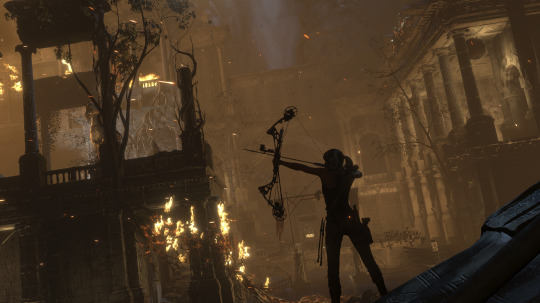
This experience with Tomb Raider was indicative of my overall gaming experience over the past year or so. Instead of searching for enjoyment within games themselves, I feel like I’ve been using games as a vehicle to reach the enjoyment I get from earning achievements. Regardless of what game I’ve been playing over the last year, I’ve been doing so with achievements at the front of my mind. But why?

My compulsion to earn achievements took hold during my time as an Xbox 360 player. But even before then, I remember ‘collecting compulsion’ being a part of my gaming experience. I have a vivid memory of grinding kills in Advance Wars: Duel Strike in order to get medals, for example. I played through Metroid Prime using a strategy guide because I wanted to make sure I hit that 100% completion percentage.
Bringing it back to the present day, another reason for my achievement hunting is as a coping method for my huge Steam library. I’ve turned towards achievements to help to track how much of my library I’ve actually got through. And upping my achievement count while completing more of my library backlog is how I approached playing Tomb Raider. At least to a certain extent.
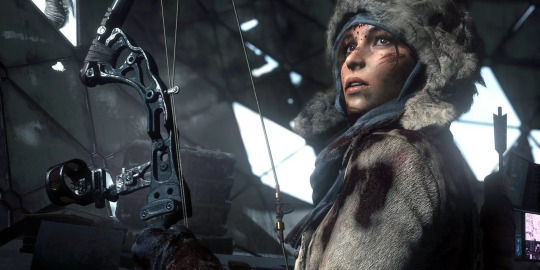
To be clear, saying that I ruined Rise of the Tomb Raider for myself is an overstatement, as I still very much enjoyed the game. The main issue that arose from my achievement hunting was specifically how much it ruined the pacing of the game for me.
Rise of the Tomb Raider employs a lot of gameplay elements that you find in open world games: Collectables, side quests, challenges, loot collection etc.
The reason these gameplay elements work so well in open world games is that it allows you to set your own pace for progression. If you want the story to advance, you can always do story missions - but you’re entirely in charge of that pace. And these games usually design their stories with this pacing in mind. The issue with Rise of the Tomb Raider is that the story hasn’t been designed with unknown pacing in mind.
For example, Lara has an ability called ‘survival instinct’ which allows her to see collectables, enemies and interactable objects much easier by highlighting them in yellow. This can be activated at any time by tapping in the right thumbstick. This translated to me pressing the thumbstick every single time I entered a new area in the game. All because I want to make sure I didn’t miss any collectables anytime I travelled somewhere new.
So instead of looking at new areas as somewhere fun to explore, my immediate reaction was to scour the area for goodies to increase my completion percentage. All to get that sweet, sweet 100% achievement.
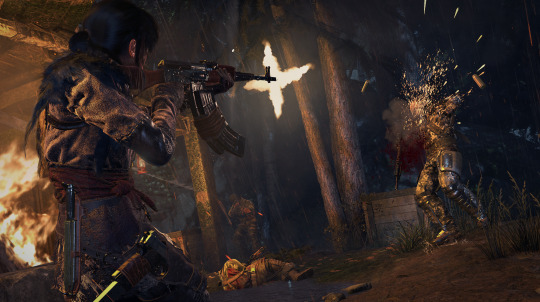
Another good example is the final boss of the game. There’s an achievement for knocking 5 enemies off platforms, and the final boss takes place on top of a high tower. So instead of focusing on taking down the boss, I spent the next 5 minutes running around and cheesing the AI into positions so I could knock them off the tower.
It wasn’t until this achievement unlocked that I felt I could carry on with the rest of the battle. And by doing this, I ruined the pacing of the battle completely, through no fault of the game. It was a pace ruining of my own making.
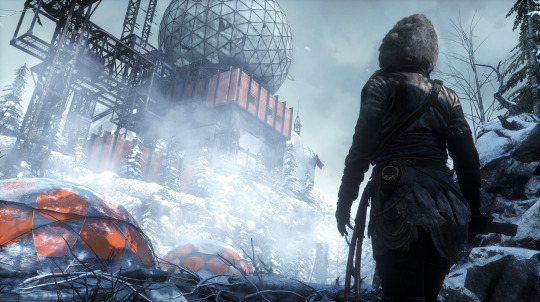
Writing this piece and reflecting on my experience of this game has lead to me questioning exactly why I enjoy games in the first place.
But should I really be concerned about what kind of enjoyment I’m getting from video games? After all, the whole point of the medium is to provide entertainment and I’m finding joy in achievement hunting! If I’d played the whole game without taking breaks to explore, would I have appreciated the better pacing as much as I enjoyed unlocking those achievements? It’s hard to say.
And it’s not like achievement hunting is dominating my overall game playing experience. Undertale was one of my favourite games and doesn’t have a single achievement. Also, all those years I spent gaming on various Nintendo consoles didn’t come with a single achievement - all the enjoyment I experienced was contained within each individual game. I’m currently playing through Nier: Automata with a very minimal focus on achievement (it helps that most of the achievements are unlocked through normal story progression to be fair...)
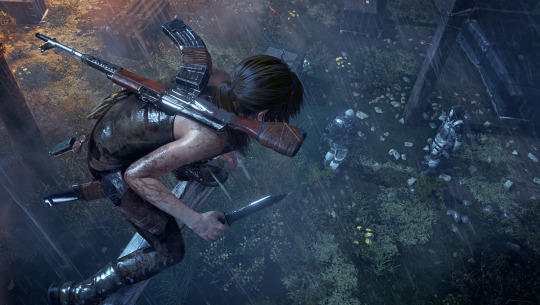
I’ll always be a completionist, that’s for sure. But does being a completionist mean I need to make my favourite entertainment medium less enjoyable?
It’s still hard for me to say just how much achievements, and the compulsion to collect them is affecting my gameplay experiences.
I think right now I need to find a balance between enjoying games as a self-contained form of entertainment and enjoying the feeling of accomplishment I get from earning a particular achievement to add to the meta-game of hunting more achievements.
#Steam#Rise of the Tomb Raider#ROTTR#Steam gaming#PC gaming#musings#my writing#achievements#game achievements#Steam achievements
1 note
·
View note
Text
Man of the Woods
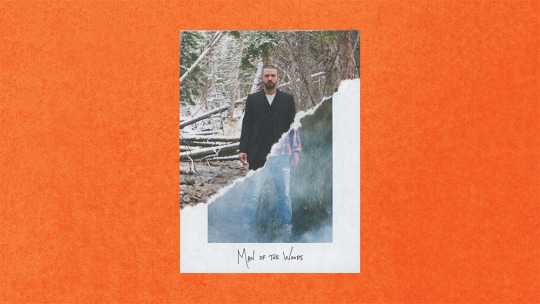
Let me preface this by saying this is my first album/music review I’ve ever done.
Also, I’m a big Justin Timberlake fan and have been since I was a young teenager. However, my love for JT comes from his solo work. The ramen hair years never particularly interested me.
And out of JT’s repertoire of songs, I’m a much bigger fan of his flashy, funky, suit twirling tracks, something that stems from me being a funk fan through and through. It’s the funky grooves combined with the amazing vocals that lead me to becoming such a big JT fan in the first place.

Unfortunately, if The 20/20 Experience was JT doubling down on his funk, then Man of the Woods is JT tripling down on his smoother, chillout style. And while his more chilled tracks can be nice respites sprinkled through his other albums, once you make a whole album out of that... you’re just not going to hold my interest.
A few songs like ‘Supplies’ and ‘Filthy’ get close to the JT I’m looking for, but there’s nothing that grooves at the same level as ‘Sexy Ladies’ or ‘Cabaret’ for example.
I realise that this is entirely a personal criticism of the album. I’m looking for Justin to provide me with a specific type of sound. Putting aside that, I think that as an album it’s perfectly passable - if you’re a fan of Justin and want something that’s mellow but occasionally funky, this album will suit your tastes fine.
Even if Man of the Woods misses the mark for me, I can still appreciate the fact that Justin has the range to go from 20/20 to an album like this. Appreciating something for the skill it requires and enjoying something because it’s hitting those funky rhythms I want to jam to are two very different things though.

Also, it’s easy to see that this album means a lot to Justin. Just watch his video for ‘Man of the Woods’ and you can see how much fun he’s having with the whole thing. As a big fan of Justin not just for his music, but as a person in general, it’s hard not to appreciate that he’s doing something that makes him happy.
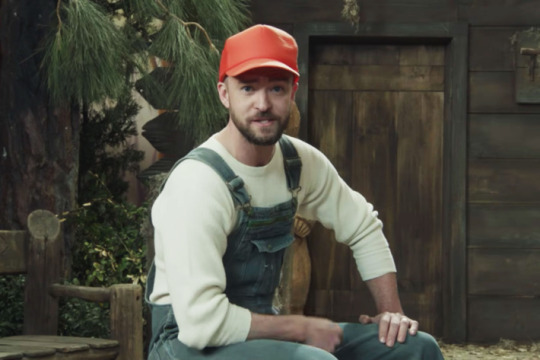
Am I disappointed that I’m not getting my usual funk from Justin? Sadly, yes.
Is it as bad an album as everyone is making out? I don’t think so.
1 note
·
View note
Text
Ending the year with betrayal (at House on the Hill)
I spent New Year’s Eve trying out some new (to me at least) board games with friends over drinks in what was a great evening. We played two games: Betrayal at House on the Hill, and another game called ‘Boss Monsters’
Boss Monsters didn’t impress me all that much. The game lacked interaction between players and I felt like there was too much information to track in order to maximize your resources. It always sucks in games to find out a choice you made was incorrect just because you didn’t notice something across the table.
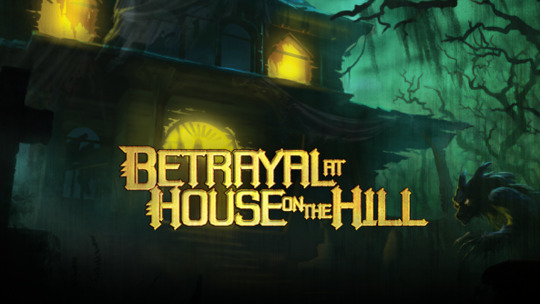
However, the other board game I played that night left me very impressed.
Betrayal at House on the Hill is a board game for 3-6 players, which I played in a group of 5. You each play as a character tasked with exploring a haunted house that is randomly assembled by using tiles to represent each room you enter.
As you play, the house gets slowly bigger as you uncover items, stat changing effects (both positive and negative) and more rooms. While this is happening, you creep ever so closer to the end-game... the haunting itself. Most of this review is going to be discussing this haunting mechanic, as it’s this feature that lead to me being as impressed as I was with Betrayal.
You begin each game working together until a ‘traitor’ is revealed when the haunt begins. When this happens, all the players are given a condition they must meet in order to win, and the traitor is given their own win condition, which often goes directly against the win condition of the rest of the players. These win conditons vary depending on the haunt, and there are over 50 different kinds of hauntings to play through, most of which drastically change the game rules.
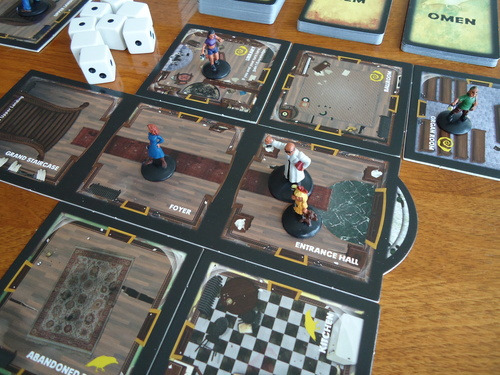
Often, games with as many random elements as Betrayal fall foul of leaving players feeling as though they are having no impact on what happens in the game. Betrayal gets around this by making the ‘Haunt’ where the primary decision making takes place. As these later decisions are heavily impacted by the random elements of the early game, it makes these early elements feel more exciting. When you find a powerful item, you’re not excited about what it means right now, you’re excited about the implications this discovery will happen once the haunt begins.
The social element of the haunt is also something I’d praise. You go into each game knowing there will be a traitor in your midst, and the anticipation for the reveal adds to the fun. Turning against your former allies carries a sadistic form of pleasure that’s hard to deny.
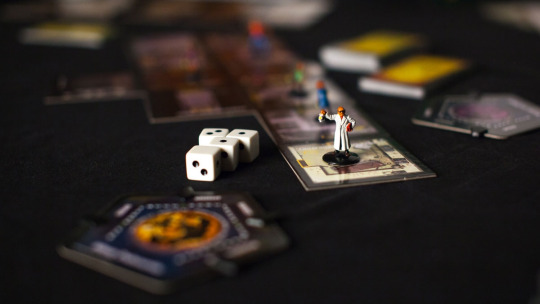
I was impressed by how much the haunt was willing to change the core mechanics of the game too. Whole new gameplay mechanics can be introduced for the sake of a single haunt, adding to that ���no two games play the same’ draw. This is a feature that heavily encourages repeat playthroughs, greatly increasing the value prospect of picking up a copy of this game.
While the haunts that we ended up playing didn’t seem like the best the game had to offer, the fact that the strength of the game shone through regardless is a testament to the quality of Betrayal.
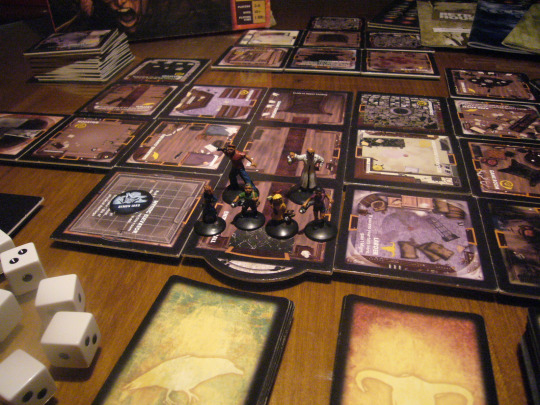
As anyone who’s read one of my video game reviews will have picked up by now, I’m a huge fan of rogue-likes. Games with a strong core that encourage repeat playthroughs appeal to me immensely, and Betrayal takes that idea and perfectly transitions it to the medium of board games.
I’m definitely going to keep an eye out for chances in the future to play Betrayal again. The fact that each haunt will play differently depending on who the traitor is means that I can imagine this game staying entertaining for a long time - as long as the playgroup is right of course.
#Betrayal at House on the Hill#Betrayal#BAHOTH#Board game#board game review#my writing#review#board games
1 note
·
View note
Text
Transfer complete!
For anyone unaware, I recently transferred all my content from my old Tumblr onto this new one, so that I can better engage with other writers and use this platform in a much more efficient way.
If you’re following me onwards from my old blog, then thanks for sticking around! I appreciate it, and look forward to writing a whole bunch more.
0 notes
Text
Flinthook, or why Switch is great for indies
Originally, I was going to write a piece about how Flinthook is exactly the kind of game that deserves a second chance on the Nintendo Switch. But in between my first draft and finally publishing this piece, Tribute Games went ahead and confirmed a Switch port.
I guess I’ll take that as a sign of my good judgement?
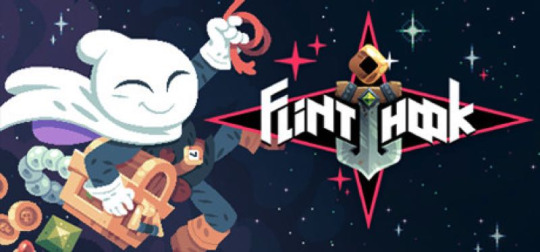
So instead of making an argument as to why Flinthook deserves a Switch port, I’ll be telling you why you should buy Flinthook for your Switch.
But how do I already know that Flinthook is a great game for portable play? Well, thanks to my recent purchase of a GPD WIN, for the past few months I’ve been able to take the PC gaming experience with me on the go. That included playing Flinthook on my commute to and from work for hours on end. And oh boy is Flinthook amazing on a portable system.
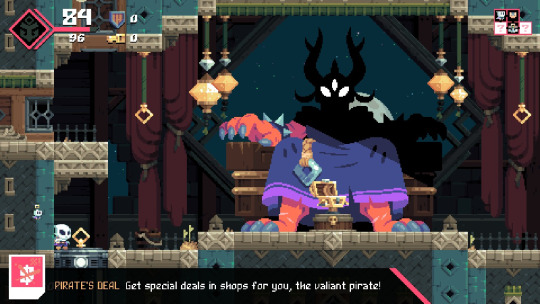
The game itself is a procedurally generated rogue-like with a focus on platforming - you traverse these platforms by flinging yourself around levels with a grappling hook.
Given that flinging yourself around levels accounts for roughly 75% of the gameplay here, it’s thankful that Flinkhook controls beautifully.
Speaking of beauty, this game is absolutely stunning in motion. Made by the same team behind the equally beautiful Mercenary Kings, Flinthook combines fluid animation with spot-on pixel art to create a game that is a true joy to look upon. I can only imagine how crisp this game would look on a Switch screen.
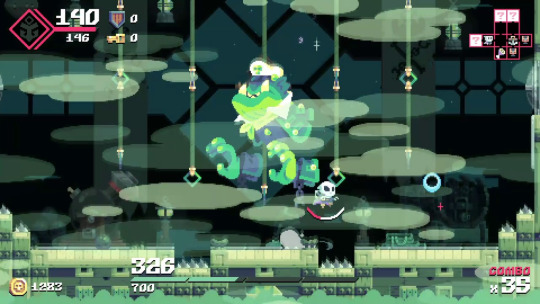
For gameplay, you use your grappling hook to pull yourself towards any of the grapple-able rings that are littered throughout the rooms of the pirate ships you board. Using the grappling hook feels natural, and the physics that determine your speed and direction feel suitably weighty. Within hours I was flinging myself through tough platforming challenges, able to anticipate exactly where I was going to land next.
Your primary method of attack is with your ‘blasma pistol’ which can be upgraded with different perks. These perks are all fairly basic, meaning your method of attack never really changes that drastically (compared to something like Binding of Isaac, where your attack changes dramatically every run).
And at any point, you can press the right trigger to activate a limited slow-mo meter (which refills very quickly). This allows you to slow down the action enough to line up shots on enemies, grapple at just the right time in order to get out of tricky situations and dodge incoming bullets.
This mechanic is great for giving you precise control exactly when you need it - and the limited usage before a recharge means you can’t overly rely on it either.
Once you combine all these mechanics together, you’ll be flipping around levels pulling off slow-mo shots that make you feel super cool. At least, they made me feel super cool.
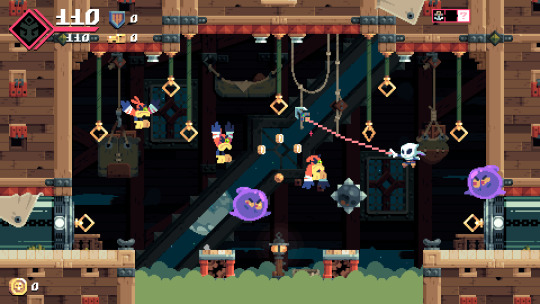
In terms of progression, Flinthook has two systems it employs to make sure you always feel like you’re moving forwards. The first are ‘Black Market Coins’ you earn by beating bosses. You can exchange these for various items and permanent upgrades through a shop in the main menu. These include health upgrades, experience boosts and hardcore versions of levels.
The other way you progress through the game is via slowly unlocked perks, which you can equip before each run begins. Not only does this keep the game interesting, as you constantly unlock new tools to play with, it also allows you to remove some of the ‘bad RNG’ that roguelikes commonly suffer from.
…But if you’re a ran of rolling the RNG dice like me, you’ll pick the perk that gives you a random selection of perks each time you play.
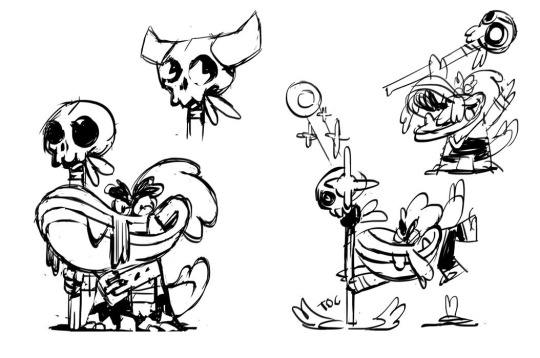
By allowing you control over the perks they can choose before a run, you can tailor your perks to fit your playstyle. You can also buy buy further perks during a run, so that even if you find a set-up you want to stick with, it’ll still feel different every time you play thanks to bonus perks you pick up while playing.
The fact that each run feels different adds a lot to what makes this a great portable game. You’re guaranteed a new experience every time you boot it up, even if it’s only for 20 minutes.
This perk system is actually one of the few criticisms I have of Flinthook - compared to other games in the genre, these perks all feel relatively tame. It’s tough to get excited about 20 different perks that all boil down to ‘You have more health’ for example.
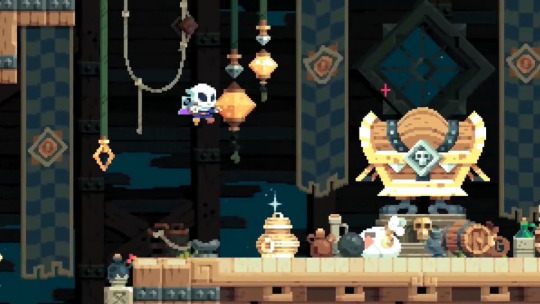
Jim Sterling recently talked about the Nintendo Switch being a haven for indies, and how the console allowed them to shine in a new spotlight away from the crowded Steam marketplace - and Flinthook exemplifies the need for this perfectly.
Flinthook is a game that deserved to be played by a lot more people than it has - Steam Spy reports that just over 60,000 people own Flinthook, with just over half of those people playing the game.
Bear in mind that this game was included in a Humble Bundle a few months ago, which no doubt boosted the number of owners dramatically.
So that’s why I’m incredibly happy for Tribute Games that they’re getting another shot at success with this upcoming Switch port. It’s one of my favourite games to come out of 2017, and I hope many more people get a chance to play it.
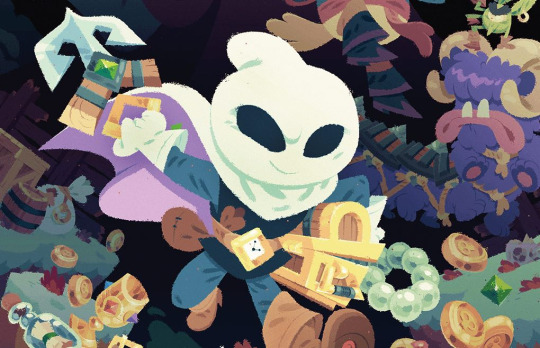
To conclude, Flinthook is a game I can’t recommend strongly enough. If you’re at all a fan of rogue-likes, or just want another game you can play in great 15 minute bursts on the go, Flinthook will make a great addition to your Switch library.
#Nintendo Switch#Nintendo#Flinthook#Nindies#video game#video game review#Switch#Flinthook Switch#Tribute Games#indie games#indie game review
0 notes
Text
Rivals of Aether is... weird.
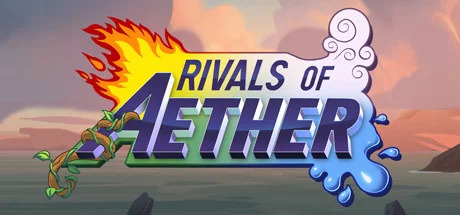
After picking it up in a Humble Monthly, Rivals of Aether was the latest game I took a crack at in order to keep getting through my Steam backlog.
What I found left me feeling oddly nostalgic, but I can’t say my experience was totally positive.
You see, when I was a teenager, I used to play a whole lot of Smash Bros. Whenever I would hang out with my friends, it was our ‘go to’ video game.
I remember logging into the Smash Bros. website daily to see what would be updated with more information about Brawl, and then talking excitedly with friends in school about new characters and stages as they came around. It was a game that defined my social experiences growing up, easily eating up 500+ hours of my childhood.
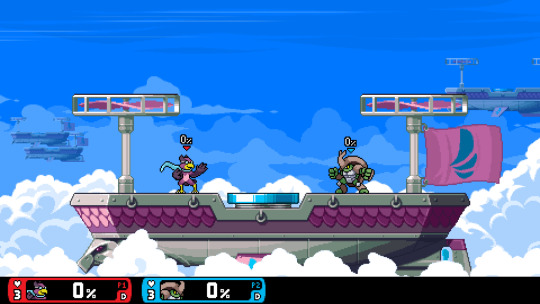
As I was a frequent user of Newgrounds during my teenage years, I also ended up checking out some ‘Smash Flash’ games occasionally - purely out of curiosity. While I never thought those Smash Flash games had much merit, clearly Dan Fornace, the developer of Rivals of Aether did.
From the moment you pick up this game, it’s super clear where the inspiration for this game comes from. Mechanically, it’s almost identical, and a number of characters have moves that are carbon-copies of Smash Bros moves. However, it’s the similarities to Smash Bros. that end up being the downfall for Rivals of Aether, at least for me.
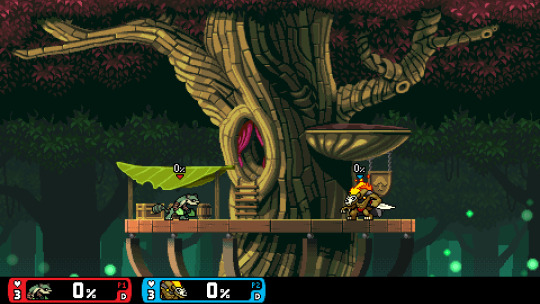
After years and years of playing Smash Bros, I’ve gained a good amount of muscle memory that I can now slip back into whenever I pick it up. With Rivals of Aether, the game is similar enough that my mind wants to fall back on that muscle memory, but it’s different enough that I can’t.
It’s like if after cooking 1,000 fried eggs, someone asked you to make an omelette. Sure, a lot of the steps are the same - but if you copy what you’re used to exactly, you’re not going to get the end result you want.
The characters don’t quite dodge with the smoothness that Smash Bros has, and characters feel much slower and less agile - the one character I felt comfortable with was the fastest in the game. Clearly, this game was designed by people who enjoyed Smash Bros. for being a technical fighting game - the changes that are made facilitate more balanced gameplay and more room for highly technical play.
The fact that Dan Fornace managed to create this game, perfecting exactly the experience he wanted from a fighting game is amazing, and something that should be applauded. Sadly, what Dan wants from a fighter and what I want from a fighter lie in different places.
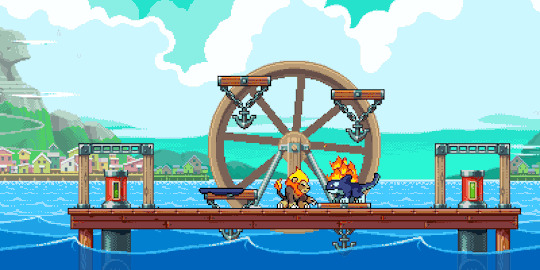
Playing this game made me realise something about myself. I’m not drawn to fighting games because of their mechanics - something I also realise as I’m trying to teach myself Street Fighter V. Instead, I’m drawn to fighting games because of what they represent, and the characters they allow me to experience.
I could boot up Smash Bros. today, and have a blast playing as a wide range of characters, and get a huge hit of nostalgia when I do so. Nostalgia not only for Smash Bros. as it’s own game, but nostalgia for the series that the characters represent too. Being able to play as Ganondorf has a weight to it that these fighters can’t hope to match.
I can’t feel nostalgia for these characters because I don’t know them - and I can’t put that aside to enjoy the game on a technical level because that’s not why I enjoy fighting games. There’s something about the experience of inhabiting that character that I enjoy, and having control over them in a situation where my own skills can be translated directly into that character’s skills as a fighter.
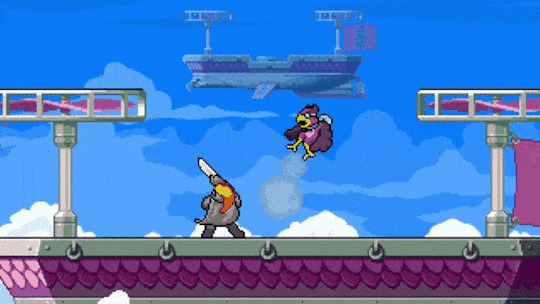
I realise that a lot of my criticisms of Rivals of Aether boil down to me explaining why it didn’t appeal to me as a game - not the actual game itself.
And for what it’s worth, the game itself is fine. I’m sure people who enjoy fighters with technical depth will find way more to love here than I did. It’s a solid fighter that I think a lot of people would have fun with, if they’re looking for a variant on competitive Smash Bros Melee with *just* the right tweaks.
In a few years, I’ll have forgotten what Rivals of Aether felt like to play, who its characters were and what I disliked about it. But that lesson about myself, and gaining that understanding of exactly why I like the fighting games I do, is something that will stick with me for a long, long time. And for that, I have to give thanks to Dan Fornace.
0 notes
Text
So I’ve been reading Parasyte
I’ve been caught up with my weekly manga series for a while now, and I’ve been on the lookout for a new manga series scratch that right-to-left itch. And in walked Parasyte, to scratch an itch I haven’t had scratched since I read Gantz for the first time.
I actually found this series by seeing a GIF of the new anime series (Parasyte - the Maxim) and being intrigued by it. A quick Wikipedia search later, and I was checking out the original manga that the show is based on. Originally published between 1990-1995, it’s clear that Parasyte set a lot of things in motion with regards to the ‘action horror’ manga genre.
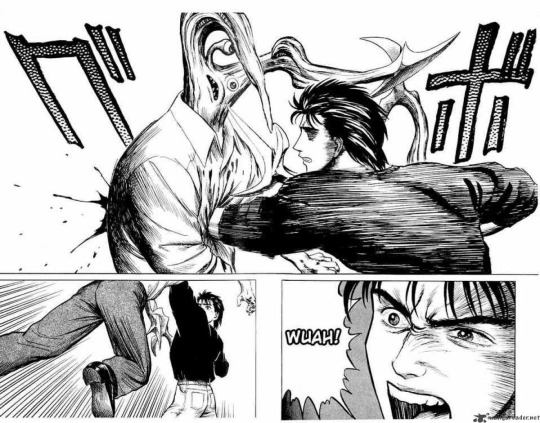
Body horror isn’t something I read very often, but I’ve managed to read some of the ‘classics’ of the genre, with Gantz and Uzumaki under my belt. I’ve also read a number of Junji Ito’s shorter stuff, which are great if you’re in the mood for some disturbing visuals. So is Parasyte better than those? In my opinion… no.
Does it do a lot of things that you can appreciate, factoring in that it came before all of those? Yes indeedy!
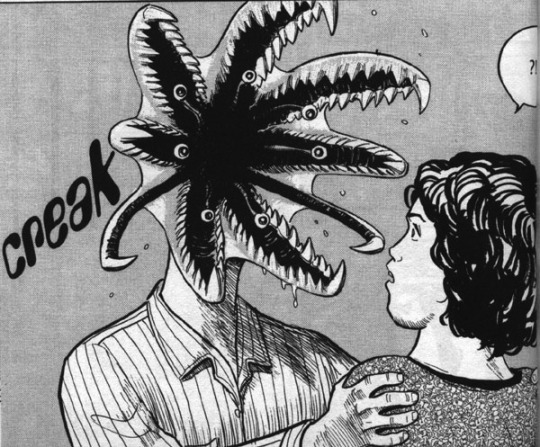
First of all, the art is top-notch… at least where it matters. The parasytes themselves are just as otherworldly as they should be, and their ability to disguise themselves as humans leads to moments where exploiting the ‘uncanny valley’ enhances the artwork even further.
The rest of the artwork just looks like any other manga though - the characters have little to distinguish them from each other, and the visuals are just there to carry on the story. I can’t really hold this against Parasyte though, because the body horror aspect of the story is the reason you’re here.
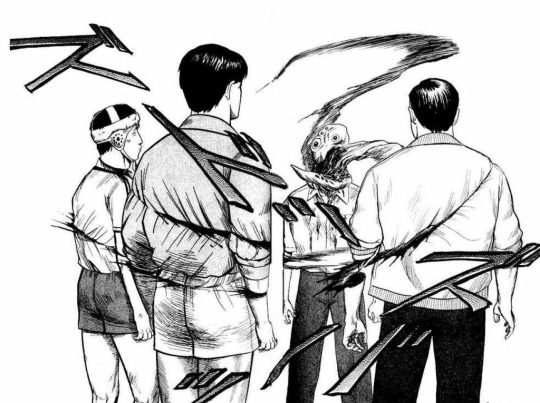
The story ends up hitting some notes that are interesting, and attempts to tackle questions regarding the nature of humanity. However, this is where the manga really starts to show it’s age. Nothing is really handled here that hasn’t been brought up before in 1000′s of pieces of media, and over the years we’ve learnt to do it a lot better.
Our main character starts losing his humanity as time goes on, which is an interesting premise… but in the manga, this is conveyed by him slowly losing interest in his girlfriend.
Also, there are some moments that are very ‘90′s stupid’. But hey, you can’t be too harsh to a product of the time for being a product of the time.

So is it worth reading Parasyte? I’m going to have to say no. There are much better mangas that have a focus on body horror (such as Gantz) and much better stories that deal with the ‘what makes us human’ question.
If you’re interested in seeing the artwork that drew me into the series, a quick Google image search will throw up the best ones.
But if you’re a big fan of horror manga and want to see where the more modern stories got some of their inspiration, there’s still something to be gained from reading through the series - just don’t expect to be blown away!
0 notes
Text
Super Short: Hero of the Kingdom
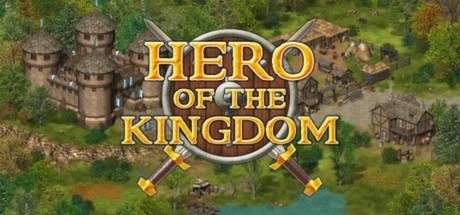
It’s tough to write much about a game I beat in under 5 hours… but here I go.
Hero of the Kingdom is a weird cross between a point and clink and a resource management game. Resource management would be implying a depth to this game though - in reality, it’s more of a ‘resource exchange’ game.
The story is so basic as to be entirely dismissable. You start off as a young boy, adventure across lands helping people and improving your skills/gaining new allies until you have a final battle with a guy literally called ‘The Dark Lord’. Most stories are at least constructed from a number of tropes, but the story here feels like it’s just one single trope.
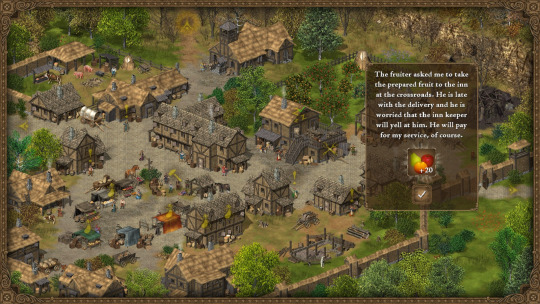
Like I said earlier, the game comes across as a point and click combined with resource exchanging. Every single obstacle you face in the game requires you to have certain resources before you can accomplish it.
These resources can be equipment, weapons or food. Your health itself is even considered a resource, as you have to make sure you have enough stamina to accomplish certain tasks. So to get meat, you need to hunt deer - which means you have to have arrows, which you get by giving gold to the hunter… and so on and so on.
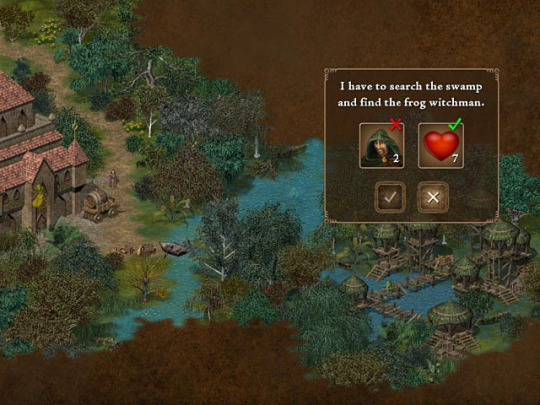
The result is a game that involves a lot of busywork as you flick from person to person, attempting to turn one resource into another via a 4 step program.
As a short distraction to play on the train while I listened to a podcast, this game did a perfectly acceptable job of keeping me occupied with some mindless busywork.
The idea of sitting down at your PC to play this though? Maybe if this was a flash game in the early 2000′s, but even then I’d have better recommendations…
0 notes
Text
Ziggurat and the Rogue-lite Pallet Cleanser
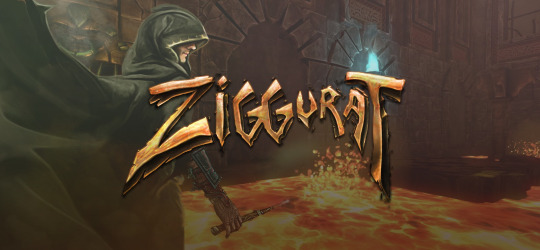
For at least 2 years, I’ve been playing a lot of Magic: Duels on Steam. And by a lot, I mean I’ve sunk at least 400 hours into it. There are 3 main reasons for this:
I’m a big Magic: the Gathering fan
It was an excellent game to play while listening to podcasts
There was an achievement for completing 500 daily quests, which I became compelled to achieve after sinking enough hours into the game.
A few weeks ago I managed to get the achievement for completing 500 daily quests, which means I could happily put it down forever and find myself another game to play while I listened to podcasts.
That’s how I stumbled upon Ziggurat.
I started my search for such a game with the rogue-lites I own already on Steam. Rogue-lites are a great genre to play while listening to podcasts in my experience, as they’re both story light and gameplay focused. There’s no cutscenes that I need to worry about missing and most of these games tend to fall into a ‘rhythm’ where you’re doing the same thing over and over again.
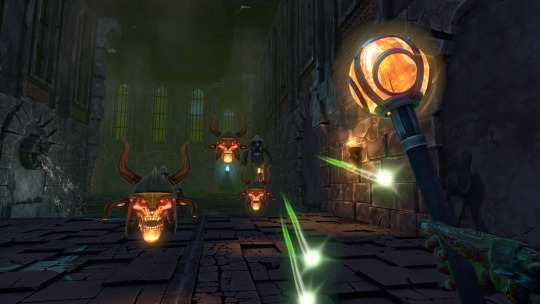
Now when it comes to rogue-lites, I find it easier to discuss the mechanics by splitting them into two categories - first, the mechanics of how the game handles (controls and combat etc). Then, how the game encourages repeat playthroughs through the in-game mechanics. It’s the second part that makes a rogue-lite what it is, and also what usually differentiates it from others in the genre.
For the gameplay, the closest comparison I can make it ‘classic’ FPS games like Doom or Serious Sam. Not only does Ziggurart control like those games, but each combat encounter is structured similarly too. You enter a series of rooms, and have to fight off waves of enemies, strafing and firing off shots until either you or the enemies that fill the room have died.
This core aspect of the game is solid. Unless you’re playing a slow character, you move at a blistering pace through each room - especially when sprinting. I never felt like dodging shots was impossible, and jumping around to clear rooms quickly is satisfying. Enemies aren’t very diverse however, so you don’t really need to adapt your strategies that often. Once you find the ‘optimal’ way to dodge and shoot at foes, that technique can be applied to every fight.
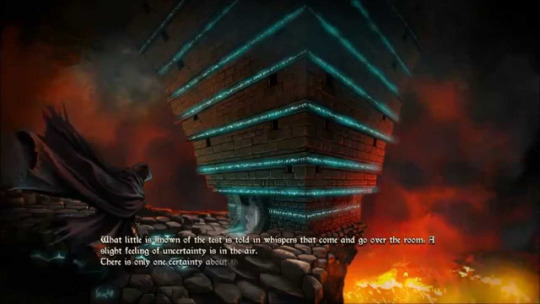
Ziggurat encourages you to play again and again in a number of ways, but the main way is via unlocking new perks and choosing different ‘characters’ to play.
Each time you level up in a run, you’re (usually) presented with two different options to choose from. These perks can range from simple damage/speed increases to more interesting perks that make you take more damage in exchange for letting you level up faster.
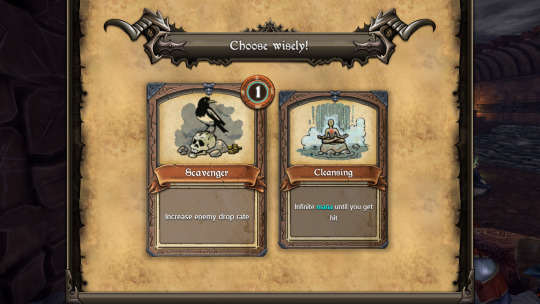
Along with this perk system, there are a number of different characters you can play as. While none of the characters are so radically different that it changes the core gameplay experience, they’re different enough to make you change your playstyle. Some will encourage you to focus more on dodging due to their fragile health, while others encourage you to blitz from room to room due to an ever-draining life meter - which can be filled by killing enemies.
Unlike the items in Binding of Isaac, 80% of the perks you can acquire don’t actually change your overall plan. Sure, some perks will mean you’re more aggressive or reserved when taking on encounters, but how you play the game doesn’t really change.
I couldn’t help but contrast the character options in Ziggurat with Rogue Legacy, a game in which getting certain negative traits could make a run fundamentally different from your last. This goes a long way to encourage repeat play for me, as it doesn’t feel like you’re playing the same game over and over again.
Unfortunately for Ziggurat, it doesn’t do enough to make each run different. And while this wasn’t a huge issue for me as I enjoyed Ziggurat, I can see this being an issue for other players.
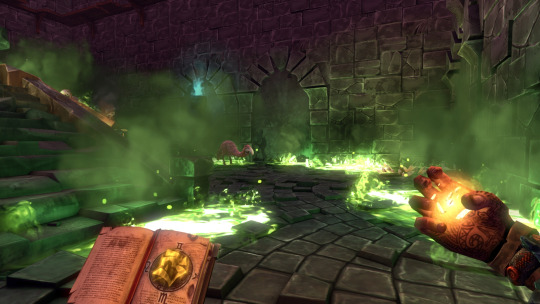
Another issue I have with Ziggurat is that to begin with, your possible unlocks in each playthrough are very limited. Also, with only 5 floors and a limited pool of enemy types, chances are you’ll have seen 90% of what the game is going to throw at you after your first 3 playthroughs.
Put all these things together and it means that once you understand the core mechanics, other than the different perks you get when levelling up, Ziggurat pretty much stays the same each time you play it.
For a roguelite, this goes against what most people are looking for. The good thing for me is that I wasn’t really looking for a new experience each playthrough. As I wanted to just put this on as something to play while zoning out to podcasts, the fact that the core mechanics didn’t change actually worked in the games favor!
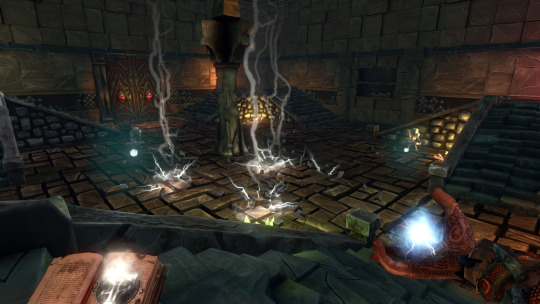
As I came into this game with a rather odd requiremements, I have a strong suspision that I had a better time that I would have if I was looking for something in the caliber of FTL or Rogue Legacy. So while you should take my recommendation with a grain of salt, I’d like to think I still have some sense of what makes a game enjoyable!
My final recommendation: Give it a try, and if you don’t like it before you’ve sunk 2 hours into it, then you can rest assured that you wouldn’t like any of the hours after that.
But, if you do like those first two hours, then Ziggurat is a damn fine game to sink some time into.
#Ziggurat#video games#video game review#review#my writing#games writing#steam#pc gaming#ziggurat game
0 notes
Text
A year late, I’ve finally played Overwatch
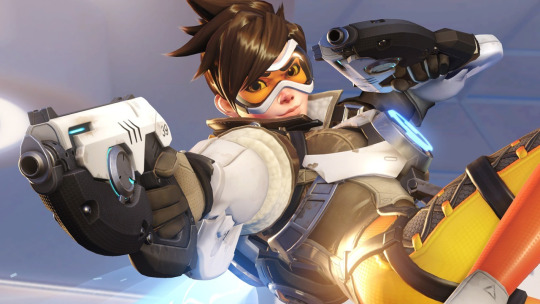
Talk about late to the party, right?
I’m generally not a fan of games with a multiplayer focus, let alone games that are only multiplayer. These days, I enjoy keeping my game experiences diverse and changing things up regularly - gone are the days when I’d sink hundreds of hours into Halo 3 or Call of Duty: Black Ops II. So far that reason, I didn’t put down the £40 when Overwatch first came out.
Nowadays though, it drops to a much more approachable £20 when it goes on sale, which is exactly what it dropped to when I finally picked it up. Even if I didn’t play it a huge amount, £20 for a game with Overwatch’s level of quality was totally acceptable to me.
And was I right to wait? Well… yes and no.
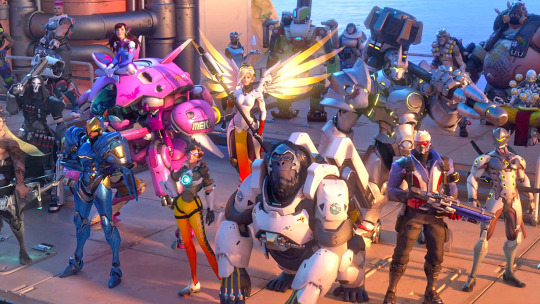
While Overwatch still gets discussed in a number of the podcasts I listen to (thanks to new hero additions and seasonal events) it’s nowhere near the ‘Overwatch fever’ of a year ago. Anyone who’s been a long time listener of the Co-Optional podcast can attest, Overwatch was talked about A LOT both pre and post launch.
Also, a lot of my social circles involve people who are big gamers. So even though I didn’t actually play any Overwatch myself, I was exposed to a lot of discussion around it regardless.
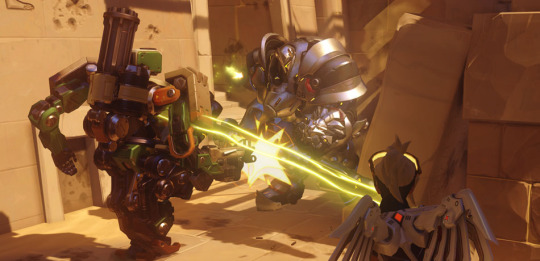
So after a year hearing second-hand about it, I launched Overwatch properly for the first time, and play my first three matches.
In each match, I try out a few different characters, but ultimately I fall back on using Mercy, simply because I have no idea what I’m doing. If I played as any other character, I was left feeling like I was always making the wrong choices. I was picking fights against characters that were naturally good against the one I was using.
I was getting lost on maps because I didn’t know which way to go to best reach key points. I also had no idea where health packs usually spawn, leading to me running around looking all over for them.
Thankfully, Mercy was there for me to fall upon.
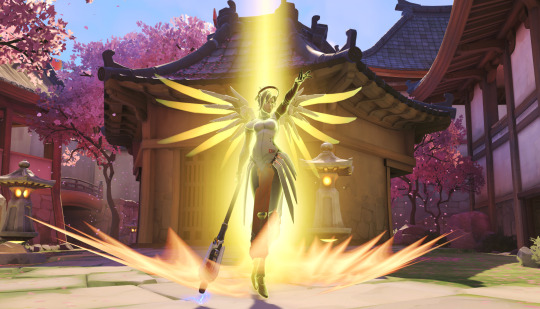
Similarly to the medic in TF2, Mercy provided me with a method of playing Overwatch that meant my newness to the game wasn’t a hindrance to my team. I mean, I’m sure I was still a pretty bad Mercy, but that’s beside the point.
I didn’t need to know how to combat my opponents tactics, because my only tactic was to support my team. I didn’t have to worry about my health, because Mercy automatically regenerates hers.
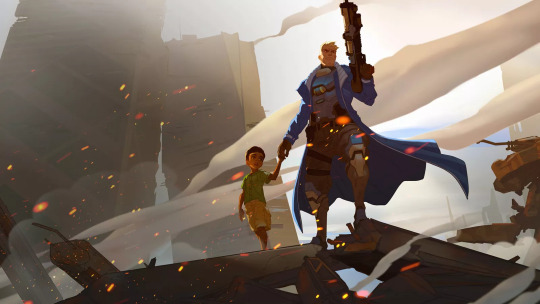
Once I felt I’d had enough experience in how Overwatch’s core mechanics worked, I switched to my closest frame of reference when it comes to FPS games - Soldier 76. From my time spent listening to Overwatch discussions, I had been able to pick up that Soldier 76 was the closest character in the Overwatch roster to how Call of Duty plays. And this is true not just of his gameplay, but also his play style - just as you’re rewarded for flanking and map knowledge in COD, so you are with Soldier 76.
Thanks to the knowledge I’d gained from playing Mercy, I felt like I was now actively contributing to my teams success in a visible way.
And once I’d got the hang of Soldier 76, I quickly snowballed into trying out the rest of the roster with much more confidence.
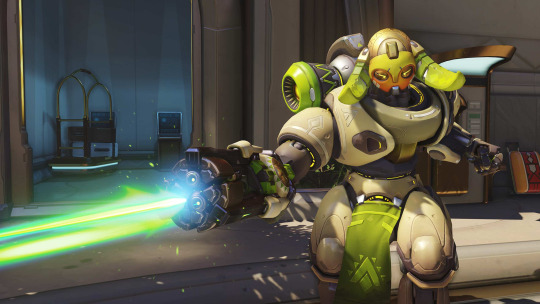
In my experience since then, I’ve found that I naturally gravitate towards more ‘tanky’ characters such as Orisa and D.Va when I play. There’s a lot less pressure on these characters when it comes to precision aiming, which suits my relaxed play style to a tee.
Playing with friends
Now, as a team based first person shooter, Overwatch is best enjoyed with friends. And it’s a testament to Overwatch’s staying power that despite my friends having owned it for over a year, they were all willing to jump into a game with me when I asked. And as a team game, it works really well! I found that if I wanted to work together with my friends I could, but it didn’t require the CS:GO levels of co-operation that I dislike. Calling out enemy placements can be fun, but nowadays I just want to kick back and relax when I play a game.
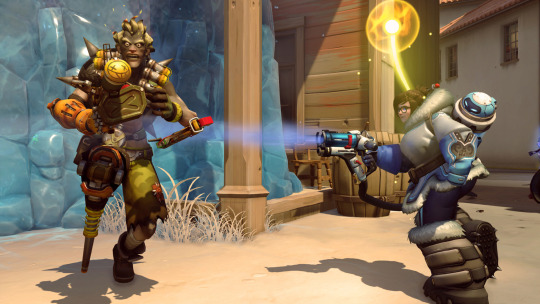
Of course, some of these friends found it hilarious that I had no idea what most of these character did. Oftentimes I’d have to ask over voice chat what my ultimate did for a certain character, as I was afraid of wasting it.
I’d also often ask for advice from my teammates if I was having difficulty against a certain character on the enemy team - not all the counters are as obvious to me as others.
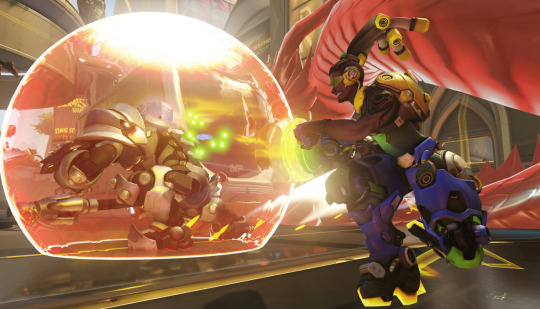
So, am I unhappy with my purchase of Overwatch?
Not really.
After spending so much of last year being bombarded with discussion about it, and knowing so many friends that enjoy it, it felt like I was finally joining in a conversation I’d been on the edge of since it had come out.
I’m not actively now playing it, but paying £20 to be part of that conversation is a fine price in my eyes.
Joining the conversation
My final note on Overwatch is regarding that ‘Joining the conversation’ feeling. Despite not playing the game myself for such a long time, I still found myself enjoying both the character designs and Blizzard’s cinematic shorts for it.
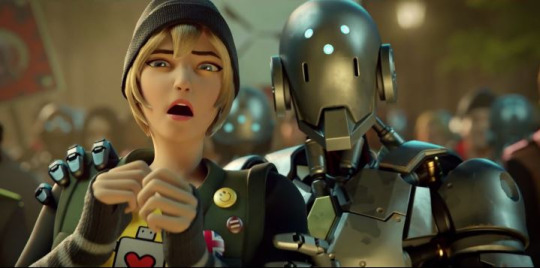
However, it always came with a reservation. As I’d never actually played the game, it felt like I couldn’t go around wearing an Overwatch t-shirt, or talking about how cool the latest cinematic was because I hadn’t actually played the game. This isn’t a negative per-say, as the point of a lot of the media Blizzard put out regarding Overwatch is designed to do just that - make you take note of this game you’re missing out on. And as my £20 now adds to the huge money pile they’ve made from this game, clearly it worked.
It’s not uncommon for video games to push themselves as something you need to buy so that you don’t ‘miss out’, and Overwatch is the biggest example of how advertising can create that feeling.
One final, final note.
Despite me not being able to play her at all, Sombra is my favourite character in the roster. What can I say, I’m a sucker for an undercut.
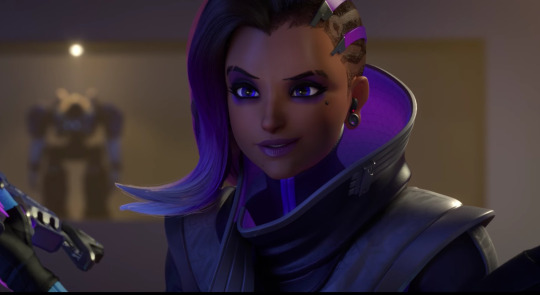
0 notes
Text
So I’ve been listening to Starship Troopers
Thanks to my new job, I now have a 50 minute commute every weekday - which means I’ve got lots of time to catch up on podcasts and for the first time in my life, audiobooks.
To start off my venture into audiobook-land, I picked up a load of classic sci-fi novels… and the first novel I’m listening to out of that batch is Starship Troopers.
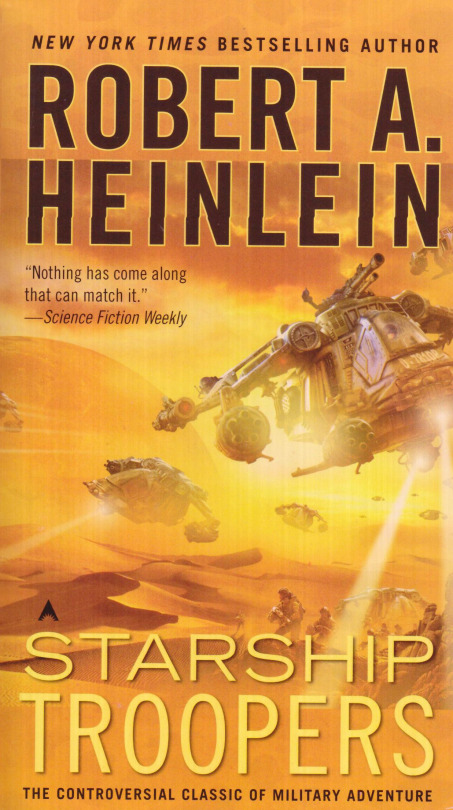
The Novel
While listening to this novel, I found that I often needed to remind myself of the time this novel actually came out. If it had come out in say 2014, I’d call it a strong novel that continues exploring themes we see commonly in militaristic fiction nowadays. Considering the time it did actually come out, I actually have this novel to thank for a lot of the games, movies and novels I enjoyed as a teenager.
It’s a strange experience to discover the origin of so much of the media I’ve enjoyed, that’s for sure. From Halo to Mass Effect and Star Wars, I can see how not only the technology, but the way the narrative looks at the functions of the military in a critical manner has continued to be explored in many other directions.
Of course, it’s also interesting to see what caused these things to be explored in the first place. A classic ‘coming of age story’ Starship Troopers uses the transformation of it’s main character as a vehicle to demonstrate the positive influence that the military can have on a person. Despite being a low ranking member of the military, by the end of the novel, our main character is so elevated as a human being compared to civilians, it borders on ridiculous. I very much doubt that it’s an accident that the novel becomes more structured, focused and interesting as his time in the military structures our narrator into a more focused and interesting person.
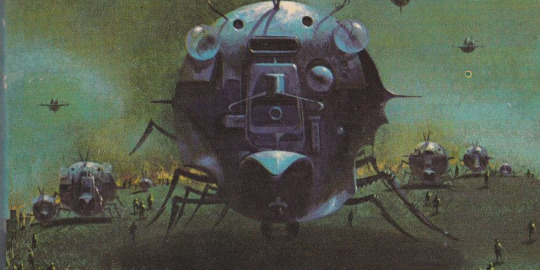
Final thoughts
Despite the cheesy impression I had from what I had seen of the movie adaptation, I was pleasantly surprised at how good Starship Troopers was. At it’s core, it’s a novel about the positive effect that a militaristic ruling system can have on society.
With such a focus on these philosophical ideas, there are a few characters who serve as mouthpieces for the points that the author wants to get across - Mr. Dubois being the stand out example. This shouldn’t be construed as a negative though. Through his discussions with our main character, we’re presented with a number of contemporary ideas regarding military function, taken to the extreme, I often find that taking an idea to it’s absolute extreme can be an excellent way to explore all the nuisances - by realising why you can’t take an idea that far, it’s easier to understand why it’s currently being taken as far as it is.
Finally, the greatest praise I can levy at Starship Troopers is that it fundamentally changed my outlook on the military - something that I previously had not much of an opinion on. While it’s not quite enough for me to jump up and enlist, it’s given me a better understanding of the people who are enlisted and commend the way being in the military had changed them.
And no, I’ve never watched the movie. Once I get a better phone (I’m currently one of 10 people in the world who owns a Windows Phone) I’m going to start putting movies on it. Having a long commute also lends itself to getting through those classic movies I’ve never got around to watching. So you can bet that Starship Troopers is going on my list of things to watch!
And I’ll write about it too. Promise.
2 notes
·
View notes
Text
My thoughts on Song of the Deep
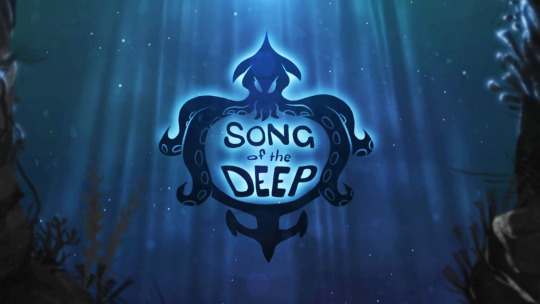
‘Metroidvania’ is such a strange term to me. For those who don’t know what it means, it’s used to describe video games that follow the progression system often seen in Metroid and Castlevania games.
And while a lot of the genre describers in video games describe the kind of gameplay you can expect (FPS, RPG, Puzzle, Platformer, Point & Click etc) Metroidvania games are instead categorised based on how you progress through the game world.
They all follow roughly the same formula - collect items that allow you to access certain areas, where you can get different items… and so on and so forth.
Song of the Deep is a Metroidvania game, and a basic one at that - but to call it ‘my first Metroidvania’ does a disservice to both the genre and this great game.
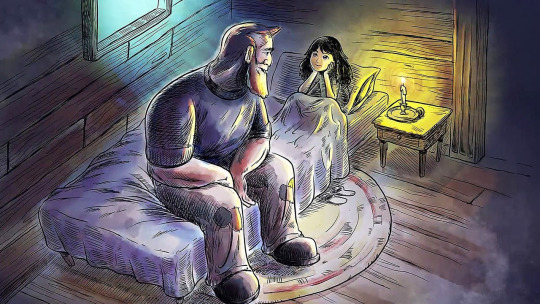
Song of the Deep follows the genre formula, but presents it in a style that’s distinct from anything I’ve seen in the genre before.
Song of the Deep is charming as hell - I was reminded of bedtime stories I was read by my Welsh grandmother as I was playing it. That’s a very hard thing to evoke in a game. The plot isn’t complex, but it doesn’t have to be.
The mechanics aren’t complex either, but again, they don’t have to be.
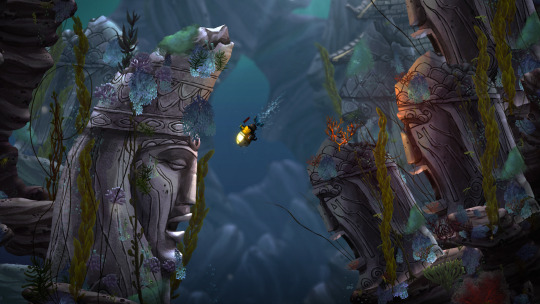
The plot of Song of the Deep is about as simple as it gets, while being as complicated as it needs to be. You play as Merryn, a young girl who’s father went missing out to sea - prompting her to build a submarine and go after him. All the cutscenes in the game are presented in a storybook watercolour style, which makes a wonderful accompaniment to the simplistic story.
And the whole game is narrated by Siobhan Hewlett, who sets the tone beautifully.
Speaking of beauty, the game itself is stunning. The backgrounds are always filled with motion, with large sea creatures slowly swimming their way across the ocean and sea life lighting up in front of you. On a couple occasions I actually stopped to just admire the scenery - something I rarely do in games.

The core gameplay is solid - Merryn’s submarine controls exactly as you’d expect it to, feeling appropriately ‘weighty’ for something that’s travelling through water. There are plenty of upgrades to grab through your adventure that adjust both the way that you play and the areas you can access.
While the combat is basic, there is much more of a focus on exploration and puzzle solving in this game than other Metroidvania style games. This suits the narrative too - you’re not space-pirate-hunting-destroyer-of-worlds Samus Aran, you’re just a small girl looking for her father.
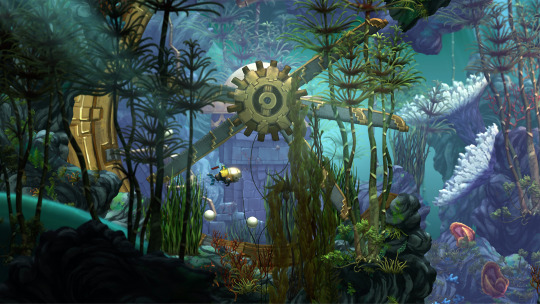
If you’ve picked up Song of the Deep in a Humble Bundle and it’s part of your backlog, or you’re looking for a cute little Metroidvania experience, I can strongly recommend Song of the Deep.
Oh, and if you’ve never tried a Metroidvania style game before, this is a excellent intro to the genre.
0 notes
Text
Here’s why I didn’t enjoy Deadlight
There’s starting to be a recurring theme here on my blog… I’m writing a lot about games I’ve been playing to get through my Steam backlog. Some of them have been great, others not so much - but good or bad, each one has given me something interesting to write about. So today, I want to talk about Deadlight. A 2007 game made at the heights of the ‘zombie fever’ (which seems to finally be dying down) and it’s an experience that’s left me with a lot to talk about - sadly for the game, not much of that is positive.
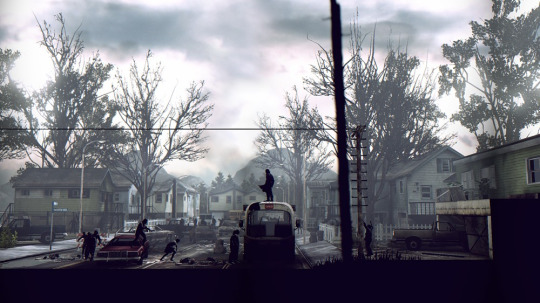
The game is what I would call a ‘grounded platformer’ similar to Limbo or the dozens of other story focused 2.5D platformers that came out around this time. You have to do all the things you’d do in a normal platformer, but unlike something like Mario where you’re presented with a fantastical world to jump around in, in Deadlight you’re jumping around a representation of our real world. Although this time it’s a lot more zombie filled than usual.
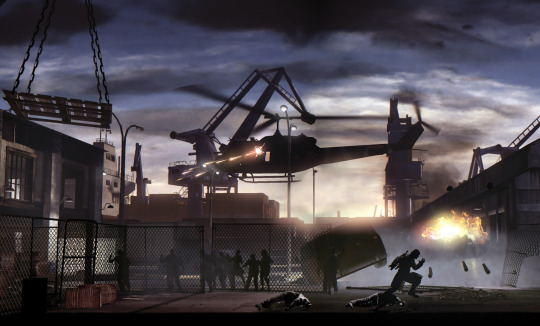
Despite the title of this piece, there are some things I enjoyed about this game. Firstly, it looks really good in screenshots. There are a whole bunch of set pieces where the 2.5D nature of the game lends itself to looking really nice.
Also, unlike 90% of zombie games these days, just a single zombie poses a real threat to you. Unlike something like Left 4 Dead where you can just go ham with an axe and get through hundreds of zombies, in Dying Light taking down a single zombie with your axe is a long process that leaves you vulnerable.
This adds some much needed tension to certain parts of the narrative, as you have to judge whether or not it’s worth taking out a zombie in your path before you continue sprinting to safety.
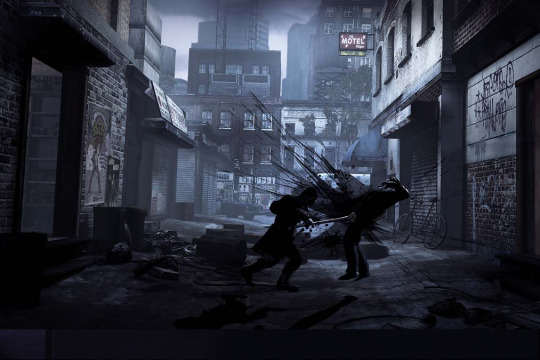
But, there’s a lot about this game that I didn’t like. First, the story goes on for far longer than it should. There’s a point where one of your allies is chained up and has to keep a zombie away from himself with just his feet.
You have to go around some obstacles to get to him… which takes about 15 minutes to do. Once you get to him, he’s still keeping the zombie at bay with just his feet.
Oh, and then the guy you just rescued needs medical attention - we’d better take a 40 minute trip to a hospital to get him some medical supplies… ignoring the fact that you’ve been finding medkits throughout the game that you’ve never picked up to carry with you.
Oh, and there’s a section of the game set underground with a ‘rat king’ who’s built an elaborate underground city, just for you to parkour all over. This whole section takes another 40 minutes or so, and has no bearing on the plot of the game whatsoever. It’s literally there to just pad out the game.
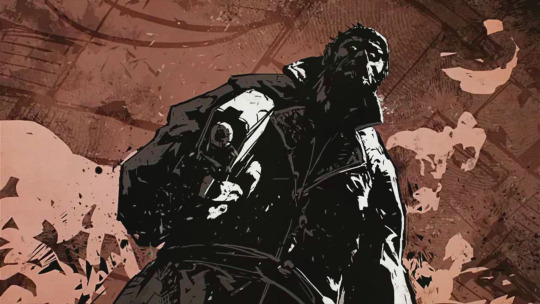
Deadlight also tries to employ the ‘twist’ narrative feature that a lot of indie darling 2.5D platformers employ. There’s meant to be a moment where ‘everything changes’ but instead you just find out something more about our main character. Sure, from a narrative point of view it’s quite a revelation - but it’s shown through a flashback from before the events of the game.
It’s presented as a major tonal shift in how we view our main character, but in a world with such a bleak tone already, it’s very hard for there to be any kind of tonal shift. You can’t go from brutal and hardhitting to brutal and hardhitting and expect the player to be shocked when you do so.
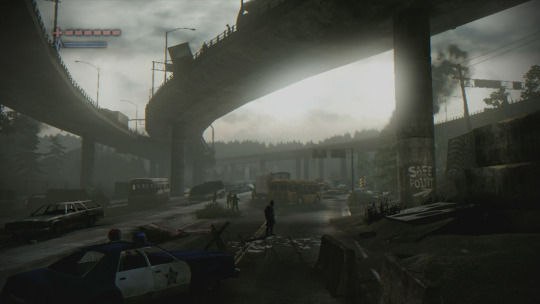
Oh, and I have to talk about the controls. They’re garbage.
The game wants to be a cinematic experience, but it wants to have all these cool moments be in engine. I can appreciate what they’re going for here, and when it works you feel really cool. All the platforming techniques you’ve learnt come together to help you escape these tense situations. But that doesn’t make up for all the times where it doesn’t work.
You’ll be running away from cool set piece, but then because you did a sprint jump instead of a normal jump, you’ll die and have to do it over again.
Oh, you didn’t realise that you’d just walked into a timed set piece where the building is falling down? Guess you’re getting caught by the falling debris and dying… guess you better try again!
You can chalk a lot of this up to the main character being ‘overanimated’. He’s meant to move in a realistic way, but this just translates to a lot of his animations having ‘locked frames’ where any inputs you make won’t actually translate to him moving in game. This is super frustrating when you’re trying to move quickly and he’s not responding because he’s in the middle of a long stumble animation.
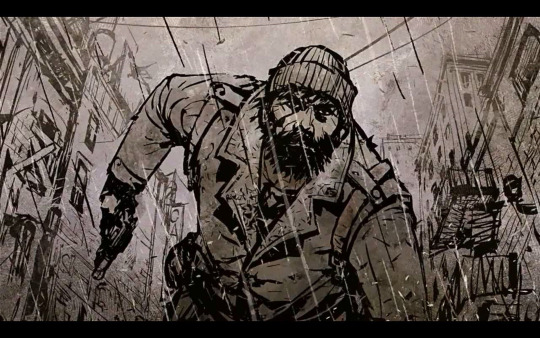
Is Deadlight worth playing? Ehhhh not really.
For being a short game (roughly 6 hours) it still manages to go on for far longer than it should. The platforming is frustrating and the story doesn’t do anything you haven’t already seen in every zombie movie/game ever.
And it’s a shame, because you can see that a lot of effort went into Deadlight. There are moments where you can see the ‘narrative platformer set in a zombie apocalypse’ idea they had shine through.
But you’ve got to wade through a lot of garbage to get there. Far too much to make it a worthwhile recommendation.
… Oh, and they call zombies ‘shadows’. According to the creative director, “they are called shadows because they are a shell of their former selves and they literally look like shadows.” So you know what. Actually, screw this game.
0 notes